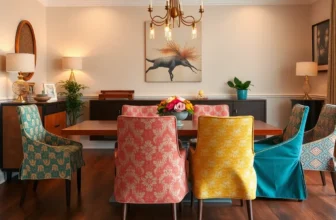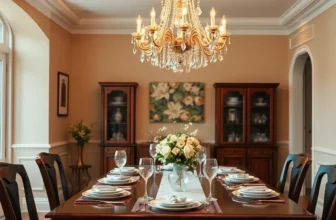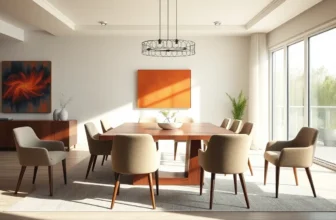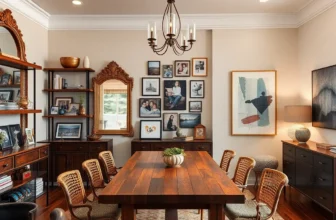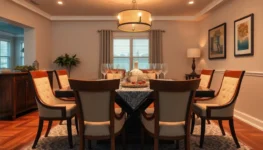
Choosing the Perfect Dining Room Table: Style, Size, and Care Tips for Every Home
The dining room table serves as the heart of any home, bringing families and friends together for meals, conversations, and celebrations. It’s more than just a piece of furniture; it’s a gathering place where memories are made and traditions are passed down. Choosing the right dining room table can enhance both the aesthetic and functionality of the space, making it a focal point in home design.
From elegant wooden designs to modern glass styles, the options are endless. Factors like size, shape, and material play crucial roles in selecting the perfect table for a dining area. Understanding these elements can help anyone create a welcoming atmosphere that reflects their personal style while accommodating their lifestyle needs. Whether hosting a dinner party or enjoying a casual family meal, the right dining room table transforms any occasion into a memorable experience.
Dining Room Table
Selecting the right dining room table involves careful consideration of multiple factors, ensuring it fits seamlessly into the home’s design while serving its functional purpose. The chosen table should accommodate the needs of the household and enhance the overall dining experience.
Size Considerations
When determining the size of a dining room table, measure the available space, allowing at least 36 inches of clearance around the table for easy movement. Tables typically range from 60 to 72 inches in length for seating six to eight people. For smaller spaces, consider tables that extend or are round, as they often create a more open feel. Ensure that the table height matches surrounding chairs, typically between 28 to 30 inches high, to maintain comfort during meals.
Shape Options
Choosing the shape of a dining room table significantly influences the room’s flow and functionality.
- Rectangular tables: Ideal for narrow spaces, these tables provide ample surface area and seat multiple guests comfortably.
- Round tables: Perfect for smaller gatherings, these tables foster conversation and fit well in compact areas.
- Square tables: Suitable for square rooms, they create a balanced look while accommodating four people.
- Oval tables: Offering a softer silhouette, oval tables enhance space efficiency while providing a larger dining area for larger groups.
Selecting the appropriate shape aligns with both space available and dining habits, optimizing the dining experience.
Materials for Dining Room Tables
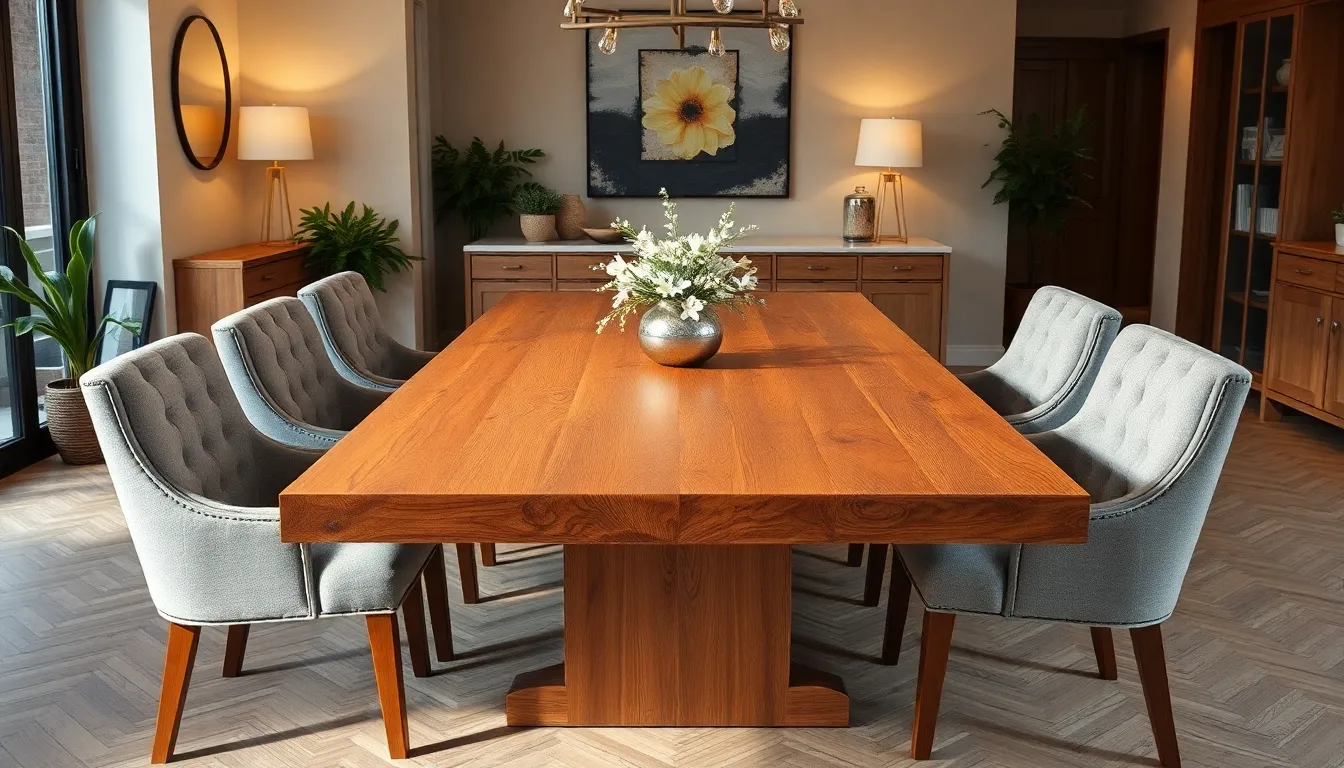
Various materials define dining room tables, influencing aesthetics and durability. Choosing the right material enhances both functionality and style.
Wood Types
Solid wood remains a popular choice for dining room tables due to its durability and timeless appeal. Species such as oak, maple, and walnut offer varying aesthetics, with oak providing a classic look, maple delivering a lighter appearance, and walnut showcasing rich, dark tones.
Engineered wood like MDF or plywood surfaces offers cost-effective alternatives with similar visual appeal. However, it’s essential to consider the finish, as high-quality finishes can protect wood tables from scratches and spills.
Metal and Glass Options
Metal and glass tables provide a contemporary look suitable for modern interiors. Stainless steel and wrought iron bases offer strength and stability, often paired with glass tops for a sleek appearance.
Tempered glass adds safety and resilience, suitable for homes with children. Metal tables can feature intricate designs, adding uniqueness without compromising functionality. These materials can create an airy feel in cramped spaces while complementing a variety of design styles.
Style and Design Inspiration
Choosing the right style for a dining room table significantly impacts the overall ambience and functionality of the space. Various design options exist, ensuring every aesthetic preference is accommodated.
Modern vs. Traditional
Modern dining room tables prioritize clean lines and minimalistic designs, often featuring materials like metal and glass. These tables create an airy environment, making them suitable for contemporary settings. Contrastingly, traditional tables display intricate detailing and craftsmanship, typically constructed from solid wood. Styles like farmhouse, Victorian, and colonial are common, highlighting warmth and classic elegance. Blending elements from both styles can yield unique, hybrid designs that appeal to diverse preferences.
Rustic and Farmhouse Designs
Rustic and farmhouse dining tables emphasize natural materials and sturdy construction. Often made from reclaimed wood, these tables showcase imperfections that add character. Their designs focus on functionality and comfort, making them perfect for casual dining. Features such as distressed finishes and sturdy legs enhance the rustic charm. Integrating these tables into a home creates a welcoming atmosphere, ideal for family meals and gatherings. Accessories like cushions and table runners further elevate their aesthetic appeal.
Maintenance and Care
Maintaining a dining room table ensures it remains functional and aesthetically pleasing over time. Regular care and proper cleaning techniques can preserve the table’s beauty and longevity.
Cleaning Tips
To clean a dining room table effectively:
- Use a soft cloth. Microfiber cloths are ideal for removing dust and preventing scratches.
- Apply a gentle cleaner. Opt for a mild soap solution or specialized cleaner suitable for the table’s material.
- Wipe in the direction of the grain. For wooden tables, always clean along the grain to maintain finish quality.
- Avoid harsh chemicals. Strong cleaners can damage finishes or cause discoloration.
- Dry immediately. After cleaning, dry the table with a clean cloth to prevent moisture damage.
Preventative Measures
To protect a dining room table from damage:
- Place coasters. Use coasters under drinks to prevent moisture rings and stains.
- Use placemats. Protect the surface during meals by placing placemats underneath dishes and utensils.
- Avoid direct sunlight. Keep the table out of direct sunlight to prevent fading or warping of the material.
- Maintain humidity levels. Keep indoor humidity consistent to prevent wood expansion or shrinkage.
- Refinish as necessary. Regularly inspect the table for wear, applying polish or re-staining as needed to maintain its appearance.
Regular maintenance and careful attention ensure that dining room tables remain the centerpiece of gatherings for years to come.
Setting the Scene
Creating an inviting atmosphere around the dining room table involves thoughtful table settings, decor, and lighting considerations. These elements enhance the dining experience and reflect personal style.
Table Settings and Decor
Table settings and decor play significant roles in establishing the mood of a dining room. Items like tablecloths, placemats, and table runners add texture and color, while coordinating dinnerware and glassware contribute to a cohesive look.
- Centerpieces enhance visual interest. Fresh flowers, candles, or decorative bowls can serve as focal points.
- Seasonal accents like autumn leaves or holiday-themed items personalize the space and create a festive ambiance.
- Functional elements should complement aesthetics. Include utensils and napkins that match the decor for a polished appearance.
Selecting decor that aligns with the table style complements the overall design while ensuring functionality.
Lighting Considerations
Adequate lighting is essential for making the dining area both practical and inviting. It enhances the ambiance and sets the tone for meals.
- Overhead fixtures like chandeliers or pendant lights offer central illumination while adding elegance. Height should hang 30 to 36 inches above the table for optimal lighting.
- Dimmable options allow for adjustable brightness. These give flexibility for casual gatherings or formal dinner parties.
- Accent lighting from sconces or decorative lamps highlights architectural features and adds warmth to the space.
Effective lighting transforms the dining room, ensuring it remains welcoming and visually appealing for every occasion.
Selecting the right dining room table is crucial for creating a warm and inviting space. It serves not only as a functional piece but also as a design focal point that enhances the overall aesthetic of the home. With various styles materials and sizes available there’s a perfect table for every household.
By considering factors like shape and clearance homeowners can ensure their table complements their dining area while accommodating gatherings of all sizes. Regular maintenance and thoughtful decor can further elevate the dining experience making every meal a cherished occasion. Ultimately a well-chosen dining room table becomes the heart of the home fostering connection and celebration.

